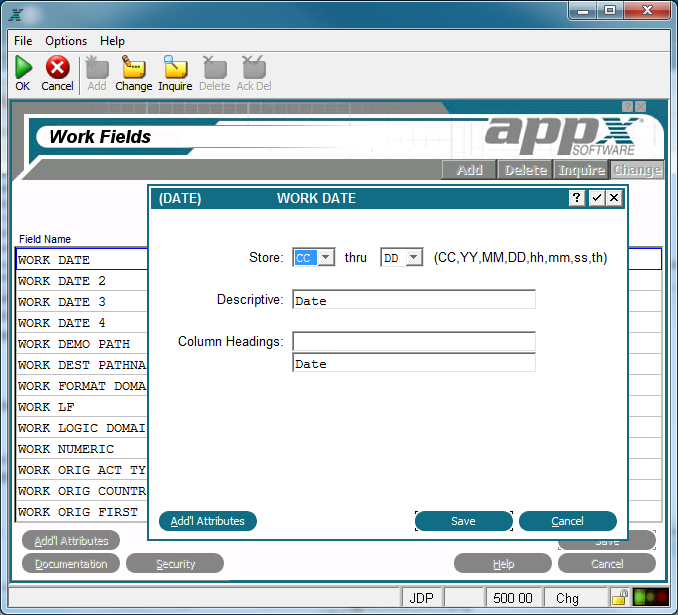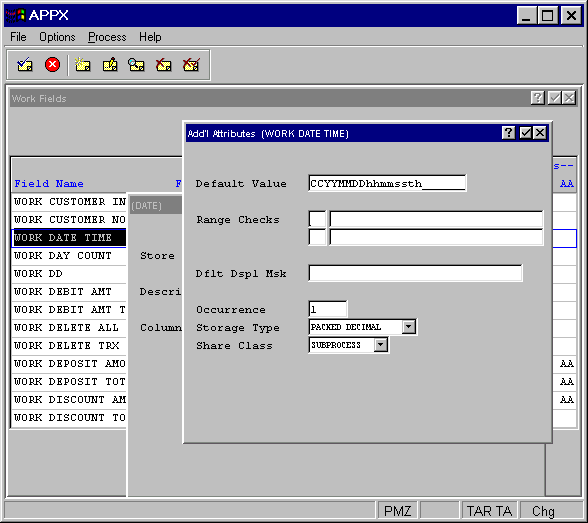Chapter 2-5: Work Fields | ||||||||||||||||
Date Work Fields A date work field contains date and/or time information. This information may, at your option, range from a century through a hundredth of a second. A work field definition may also include separator characters (such as /, -, or :) and text, including the day of the week and the name of the month. Examples of date/time work fields include invoice dates, order dates, elapsed time data, date/time stamps used to uniquely identify records, and audit trail work fields such as date-added and date-changed. The Date work fields overlay, shown below, permits you to add date/time-specific attributes to those already defined for the work field. It automatically displays after you complete the entries in the Work fields specifications screen if the Field Type you select is DATE.
Date Work Fields Overlay The Date work fields overlay contains the following fields: Store thru designates the parts of a date that are physically stored.Valid entries are:
Descriptive provides a longer, more easily understood alternative to Field Name, one that is not required to be unique within an application. If blank at all default levels, Field Name is used. Column Hdgs designates up to two lines of column heading text. The APPX output process facility uses this text to generate standard column heading images for Start of Page and Start of Range class frames. For cosmetic reasons, the length of headings should not exceed the length of a field itself. Refer to Standard Column Heading Image for additional information. The Additional Attributes overlay, shown in below, is accessible from the Date work fields overlay.
Date Work Fields Additional Attributes Overlay The date work fields Additional Attributes overlay contains the following fields: Default Value establishes a starting value for image items whenever they are first displayed in add mode on an input image, unless modified by a user. If blank, there is no starting value displayed. Range Checks defines a series of allowable values that APPX uses for online data validation. The first component represents the relation. The options are EQ (equal to), NE (not equal to), GT (greater than), LT (less than), GE (greater than or equal to), and LE (less than or equal to). The second component represents the value that is assigned to the relation. If you enter two relations, APPX infers an AND relationship. Dflt Dspl Msk controls how this field appears to a user on an APPX image, unless overridden at the image item level. If left blank, the date mask specified for the application (in Application File Maintenance in System Administration) is used or, if that is also blank, the date mask specified in System Parameters is used. Refer to the Display Mask (Date/Time) section in Using the Character Based Image Editor for additional information about this entry. Occurrence determines the number of times a field is present in a record. If blank, APPX assumes a value of 1. This field may contain up to five numeric characters and is restricted to a maximum of 32,767. See the Occurrence section for a more comprehensive discussion of this field. Storage Type determines the internal storage format of the date field. The Storage Type options are: BINARY ? The date is stored in binary format. PACKED DECIMAL stores two decimal digits for each byte. ALPHANUMERIC stores the external representation of data. The default is PACKED DECIMAL. Share Class defines at what level the values contained in this work field can be shared. The Share Class options are: SUBPROCESS The values can be shared between a process and its subprocesses. RELATED The values can be shared among related processes in a job. DETACHED The values are available until the user logs off. NOT SHARED The values are available only for the current process. The default is SUBPROCESS. | ||||||||||||||||
Application Design Manual "Powered by Appx Software"1059 ©2006 By APPX Software, Inc. All Rights Reserved |

